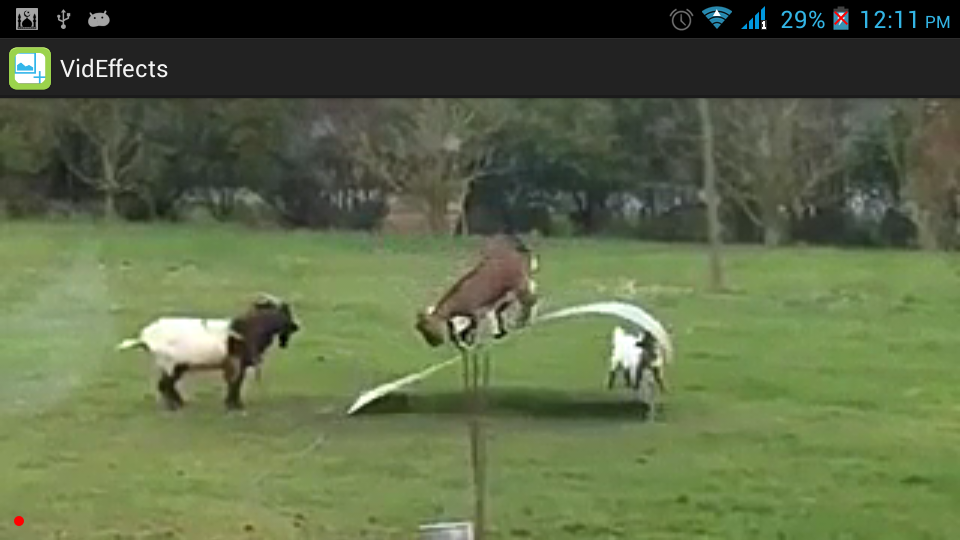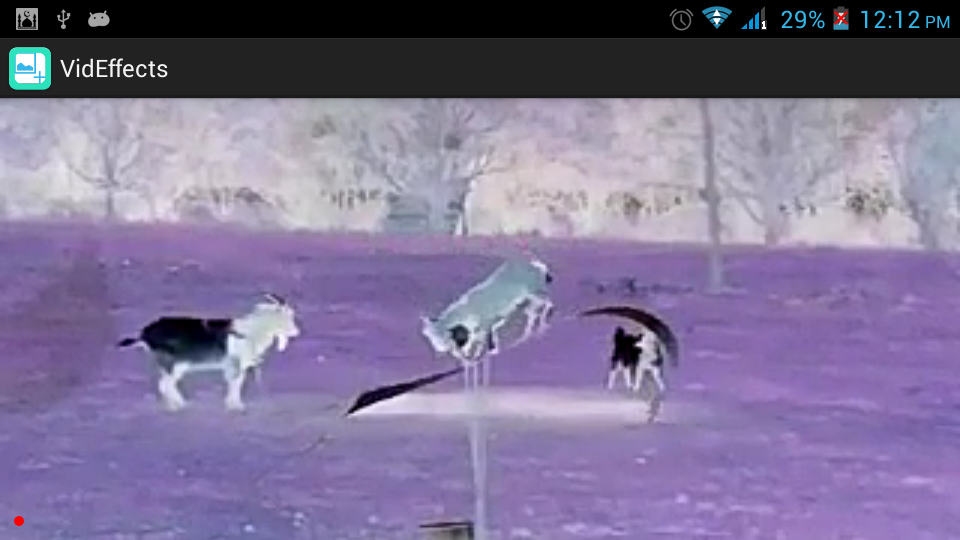I am new to the world of Open Gl and I have googled a lot but i am unable to find a way to implement Effects on a video being played. After some research i have finally found a class that can be used to play video on a GLSurfaceView. And i know from Google documentation and that we can apply effects on a video.
By following this post i was able to successfully apply effects on bitmaps. Now i want to do that for my video so any help or pointers is appreciated.
Here is the VideoSurfaceView that i am using to Render Video that is being played
package me.crossle.demo.surfacetexture;
import java.io.IOException;
import java.nio.ByteBuffer;
import java.nio.ByteOrder;
import java.nio.FloatBuffer;
import javax.microedition.khronos.egl.EGLConfig;
import javax.microedition.khronos.opengles.GL10;
import android.annotation.SuppressLint;
import android.content.Context;
import android.graphics.SurfaceTexture;
import android.media.MediaPlayer;
import android.opengl.GLES20;
import android.opengl.GLSurfaceView;
import android.opengl.Matrix;
import android.util.Log;
import android.view.Surface;
@SuppressLint("ViewConstructor")
class VideoSurfaceView extends GLSurfaceView {
VideoRender mRenderer;
private MediaPlayer mMediaPlayer = null;
public VideoSurfaceView(Context context, MediaPlayer mp) {
super(context);
setEGLContextClientVersion(2);
mMediaPlayer = mp;
mRenderer = new VideoRender(context);
setRenderer(mRenderer);
}
@Override
public void onResume() {
queueEvent(new Runnable(){
public void run() {
mRenderer.setMediaPlayer(mMediaPlayer);
}});
super.onResume();
}
private static class VideoRender
implements GLSurfaceView.Renderer, SurfaceTexture.OnFrameAvailableListener {
private static String TAG = "VideoRender";
private static final int FLOAT_SIZE_BYTES = 4;
private static final int TRIANGLE_VERTICES_DATA_STRIDE_BYTES = 5 * FLOAT_SIZE_BYTES;
private static final int TRIANGLE_VERTICES_DATA_POS_OFFSET = 0;
private static final int TRIANGLE_VERTICES_DATA_UV_OFFSET = 3;
private final float[] mTriangleVerticesData = {
// X, Y, Z, U, V
-1.0f, -1.0f, 0, 0.f, 0.f,
1.0f, -1.0f, 0, 1.f, 0.f,
-1.0f, 1.0f, 0, 0.f, 1.f,
1.0f, 1.0f, 0, 1.f, 1.f,
};
private FloatBuffer mTriangleVertices;
private final String mVertexShader =
"uniform mat4 uMVPMatrix;\n" +
"uniform mat4 uSTMatrix;\n" +
"attribute vec4 aPosition;\n" +
"attribute vec4 aTextureCoord;\n" +
"varying vec2 vTextureCoord;\n" +
"void main() {\n" +
" gl_Position = uMVPMatrix * aPosition;\n" +
" vTextureCoord = (uSTMatrix * aTextureCoord).xy;\n" +
"}\n";
private final String mFragmentShader =
"#extension GL_OES_EGL_image_external : require\n" +
"precision mediump float;\n" +
"varying vec2 vTextureCoord;\n" +
"uniform samplerExternalOES sTexture;\n" +
"void main() {\n" +
" gl_FragColor = texture2D(sTexture, vTextureCoord);\n" +
"}\n";
private float[] mMVPMatrix = new float[16];
private float[] mSTMatrix = new float[16];
private int mProgram;
private int mTextureID;
private int muMVPMatrixHandle;
private int muSTMatrixHandle;
private int maPositionHandle;
private int maTextureHandle;
private SurfaceTexture mSurface;
private boolean updateSurface = false;
private static int GL_TEXTURE_EXTERNAL_OES = 0x8D65;
private MediaPlayer mMediaPlayer;
public VideoRender(Context context) {
mTriangleVertices = ByteBuffer.allocateDirect(
mTriangleVerticesData.length * FLOAT_SIZE_BYTES)
.order(ByteOrder.nativeOrder()).asFloatBuffer();
mTriangleVertices.put(mTriangleVerticesData).position(0);
Matrix.setIdentityM(mSTMatrix, 0);
}
public void setMediaPlayer(MediaPlayer player) {
mMediaPlayer = player;
}
@Override
public void onDrawFrame(GL10 glUnused) {
synchronized(this) {
if (updateSurface) {
mSurface.updateTexImage();
mSurface.getTransformMatrix(mSTMatrix);
updateSurface = false;
}
}
GLES20.glClearColor(0.0f, 1.0f, 0.0f, 1.0f);
GLES20.glClear( GLES20.GL_DEPTH_BUFFER_BIT | GLES20.GL_COLOR_BUFFER_BIT);
GLES20.glUseProgram(mProgram);
checkGlError("glUseProgram");
GLES20.glActiveTexture(GLES20.GL_TEXTURE0);
GLES20.glBindTexture(GL_TEXTURE_EXTERNAL_OES, mTextureID);
mTriangleVertices.position(TRIANGLE_VERTICES_DATA_POS_OFFSET);
GLES20.glVertexAttribPointer(maPositionHandle, 3, GLES20.GL_FLOAT, false,
TRIANGLE_VERTICES_DATA_STRIDE_BYTES, mTriangleVertices);
checkGlError("glVertexAttribPointer maPosition");
GLES20.glEnableVertexAttribArray(maPositionHandle);
checkGlError("glEnableVertexAttribArray maPositionHandle");
mTriangleVertices.position(TRIANGLE_VERTICES_DATA_UV_OFFSET);
GLES20.glVertexAttribPointer(maTextureHandle, 3, GLES20.GL_FLOAT, false,
TRIANGLE_VERTICES_DATA_STRIDE_BYTES, mTriangleVertices);
checkGlError("glVertexAttribPointer maTextureHandle");
GLES20.glEnableVertexAttribArray(maTextureHandle);
checkGlError("glEnableVertexAttribArray maTextureHandle");
Matrix.setIdentityM(mMVPMatrix, 0);
GLES20.glUniformMatrix4fv(muMVPMatrixHandle, 1, false, mMVPMatrix, 0);
GLES20.glUniformMatrix4fv(muSTMatrixHandle, 1, false, mSTMatrix, 0);
GLES20.glDrawArrays(GLES20.GL_TRIANGLE_STRIP, 0, 4);
checkGlError("glDrawArrays");
GLES20.glFinish();
}
@Override
public void onSurfaceChanged(GL10 glUnused, int width, int height) {
}
@Override
public void onSurfaceCreated(GL10 glUnused, EGLConfig config) {
mProgram = createProgram(mVertexShader, mFragmentShader);
if (mProgram == 0) {
return;
}
maPositionHandle = GLES20.glGetAttribLocation(mProgram, "aPosition");
checkGlError("glGetAttribLocation aPosition");
if (maPositionHandle == -1) {
throw new RuntimeException("Could not get attrib location for aPosition");
}
maTextureHandle = GLES20.glGetAttribLocation(mProgram, "aTextureCoord");
checkGlError("glGetAttribLocation aTextureCoord");
if (maTextureHandle == -1) {
throw new RuntimeException("Could not get attrib location for aTextureCoord");
}
muMVPMatrixHandle = GLES20.glGetUniformLocation(mProgram, "uMVPMatrix");
checkGlError("glGetUniformLocation uMVPMatrix");
if (muMVPMatrixHandle == -1) {
throw new RuntimeException("Could not get attrib location for uMVPMatrix");
}
muSTMatrixHandle = GLES20.glGetUniformLocation(mProgram, "uSTMatrix");
checkGlError("glGetUniformLocation uSTMatrix");
if (muSTMatrixHandle == -1) {
throw new RuntimeException("Could not get attrib location for uSTMatrix");
}
int[] textures = new int[1];
GLES20.glGenTextures(1, textures, 0);
mTextureID = textures[0];
GLES20.glBindTexture(GL_TEXTURE_EXTERNAL_OES, mTextureID);
checkGlError("glBindTexture mTextureID");
GLES20.glTexParameterf(GL_TEXTURE_EXTERNAL_OES, GLES20.GL_TEXTURE_MIN_FILTER,
GLES20.GL_NEAREST);
GLES20.glTexParameterf(GL_TEXTURE_EXTERNAL_OES, GLES20.GL_TEXTURE_MAG_FILTER,
GLES20.GL_LINEAR);
/*
* Create the SurfaceTexture that will feed this textureID,
* and pass it to the MediaPlayer
*/
mSurface = new SurfaceTexture(mTextureID);
mSurface.setOnFrameAvailableListener(this);
Surface surface = new Surface(mSurface);
mMediaPlayer.setSurface(surface);
mMediaPlayer.setScreenOnWhilePlaying(true);
surface.release();
try {
mMediaPlayer.prepare();
} catch (IOException t) {
Log.e(TAG, "media player prepare failed");
}
synchronized(this) {
updateSurface = false;
}
mMediaPlayer.start();
}
synchronized public void onFrameAvailable(SurfaceTexture surface) {
updateSurface = true;
}
private int loadShader(int shaderType, String source) {
int shader = GLES20.glCreateShader(shaderType);
if (shader != 0) {
GLES20.glShaderSource(shader, source);
GLES20.glCompileShader(shader);
int[] compiled = new int[1];
GLES20.glGetShaderiv(shader, GLES20.GL_COMPILE_STATUS, compiled, 0);
if (compiled[0] == 0) {
Log.e(TAG, "Could not compile shader " + shaderType + ":");
Log.e(TAG, GLES20.glGetShaderInfoLog(shader));
GLES20.glDeleteShader(shader);
shader = 0;
}
}
return shader;
}
private int createProgram(String vertexSource, String fragmentSource) {
int vertexShader = loadShader(GLES20.GL_VERTEX_SHADER, vertexSource);
if (vertexShader == 0) {
return 0;
}
int pixelShader = loadShader(GLES20.GL_FRAGMENT_SHADER, fragmentSource);
if (pixelShader == 0) {
return 0;
}
int program = GLES20.glCreateProgram();
if (program != 0) {
GLES20.glAttachShader(program, vertexShader);
checkGlError("glAttachShader");
GLES20.glAttachShader(program, pixelShader);
checkGlError("glAttachShader");
GLES20.glLinkProgram(program);
int[] linkStatus = new int[1];
GLES20.glGetProgramiv(program, GLES20.GL_LINK_STATUS, linkStatus, 0);
if (linkStatus[0] != GLES20.GL_TRUE) {
Log.e(TAG, "Could not link program: ");
Log.e(TAG, GLES20.glGetProgramInfoLog(program));
GLES20.glDeleteProgram(program);
program = 0;
}
}
return program;
}
private void checkGlError(String op) {
int error;
while ((error = GLES20.glGetError()) != GLES20.GL_NO_ERROR) {
Log.e(TAG, op + ": glError " + error);
throw new RuntimeException(op + ": glError " + error);
}
}
} // End of class VideoRender.
} // End of class VideoSurfaceView.
And Here is my MainActivity
package me.crossle.demo.surfacetexture;
import java.io.File;
import android.app.Activity;
import android.content.res.AssetFileDescriptor;
import android.content.res.Resources;
import android.media.MediaPlayer;
import android.os.Bundle;
import android.os.Environment;
import android.util.Log;
public class MainActivity extends Activity {
private static final String TAG = "MainActivity";
protected Resources mResources;
private VideoSurfaceView mVideoView = null;
private MediaPlayer mMediaPlayer = null;
@Override
protected void onCreate(Bundle savedInstanceState) {
super.onCreate(savedInstanceState);
mResources = getResources();
mMediaPlayer = new MediaPlayer();
try {
File dir = Environment
.getExternalStoragePublicDirectory(Environment.DIRECTORY_DOWNLOADS);
File file = new File(dir,
"video.mp4");
mMediaPlayer.setDataSource(file.getAbsolutePath());
} catch (Exception e) {
Log.e(TAG, e.getMessage(), e);
}
mVideoView = new VideoSurfaceView(this, mMediaPlayer);
setContentView(mVideoView);
}
@Override
protected void onResume() {
super.onResume();
mVideoView.onResume();
}
}




draw(). github.com/google/grafika/blob/master/src/com/android/grafika/… – Nixiedraw()then which method are you referring to inVideoSurfaceView? – Itemized